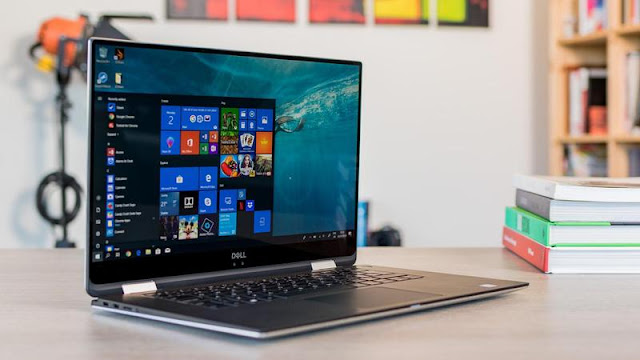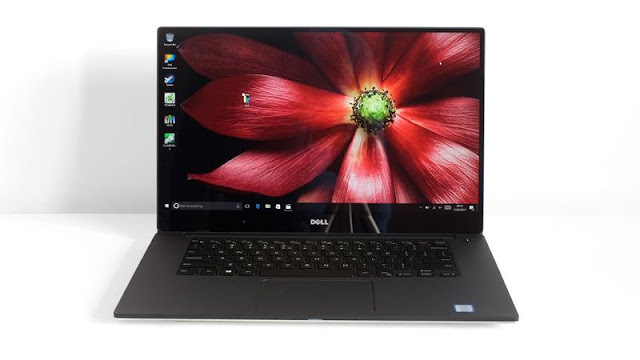Dell's 2020 XPS 13 has a great display and the best keyboard in the world, but oh boy does it run hot
A beautiful 16:10 display and the best keyboard around are enough to mean the XPS is worth anyone considering, but poor ports, overheating problems, and a steep price leave this a good laptop, but maybe not a great one.
Price When Reviewed
- From $999
Another year, another XPS 13. This time around Dell hasn’t exactly taken its flagship ultrabook back to the drawing board - you’d probably still need to set the 2020 model side-by-side with last year’s to even spot the differences - it has made some important tweaks.
They’re all good changes too, with a 16:10 aspect ratio, edge-to-edge keyboard, and Intel’s more compact and power-efficient 10nm processors to keep it even slimmer than before.
Unfortunately, many of the classic XPS 13 drawbacks are still here too, with limited ports and a tendency to run real hot. This remains one of the best laptops in the world, but Dell is going to have to do more to stay ahead of the competition next time around.
It’s not for nothing that I say that the 2019 XPS 13 was about as good as a 13in laptop got.
Of course, a 13in ultrabook isn’t the best laptop for everyone - others will want the power of gaming or creator laptops, the size of a bigger display, or the flexibility of more ports you get with the XPS 15 or 17 - but for those happy with the inevitable compromises of an ultrabook, Dell’s take on the format has rarely been bettered.
This year’s XPS 13 follows the annual rhythm of minor tweaks across the board, with two bigger changes both taken from the 2019 XPS 13 2-in-1: a larger, taller display; and a larger, wider keyboard. All in a smaller body, of course.
Let’s take the display first. The new 16:10 panel moves into the space previously occupied by the bottom bezel (and Dell logo), leaving a screen that’s all-but-borderless. There’s just about space for a webcam along the top border (which is OK, but the 720p picture is decidedly grainy), but otherwise the display is basically edge-to-edge.
It’s 13.4in diagonally, with the choice of a 1920x1200 FHD+ panel or a 3840x2400 4K HDR upgrade - that’s what I’ve been testing. The 4K panel is only available with touch support, but the FHD+ variant gives you the choice of touch or not.
Every screen variant runs to a respectable 500 nits brightness, with 100% sRGB colour gamut coverage too. You can get brighter screens - and if you’re working out in the garden a lot right now you honestly might struggle with this - but the colour range is hard to beat, and in normal lighting conditions this screen is an absolute joy to use, whether for work or for watching.
The switch to a 16:10 aspect ratio really helps. The extra vertical screen space leaves a little extra room to breathe, especially on otherwise cramped 12in or 13in models, and is especially helpful if you use it to work rather than just watch Netflix. Losing the bottom bezel doesn’t hurt either, adding to the clean, modern impression of Dell’s design.
Then there’s the keyboard. Like the display this is now almost edge-to-edge, which leaves the space for larger keycaps across the board. Even the font’s been changed - it’s thinner and more modern, with a shift to lower-case across the non-letter keys.
The edge-to-edge keys are made possible by moving the fingerprint scanner into the power key - a touch that both saves space and leaves an overall cleaner aesthetic.
Importantly, while the keyboard size was inspired by the convertible XPS, this doesn’t use the divisive MagLev keyboard that model does - instead it sticks to the same rubber dome keycaps as before, with a 1mm travel that’s as comfortable to type on as ever - and more so once you factor in the larger keys.
I feel pretty confident saying that this is the best keyboard in any laptop right now, and I honestly can’t find a single bad thing to say about it.
Despite the larger keyboard and screen, the whole body is about 2 percent smaller than last year’s - not enough to notice at a glance, but every little helps. It keeps the XPS 13 feeling ultra-portable and compact, especially since it’s lightweight despite the sturdy aluminium aluminium construction.
The downside of that is that ports have been trimmed back even further. Two USB-C/Thunderbolt 3 ports offer power delivery and DisplayPort functionality, along with a headphone jack and microSD card reader. That’s it. For some that will be enough, but others will lament the fact that other manufacturers still find the space for USB-A ports in laptops just as slim as Dell’s - vital when most accessories still use that larger port.
It’s admirable that Dell has found the space to contract the XPS 13 down further, and the changes to the screen and keyboard are entirely welcome. The aesthetic may be more functional than flashy, but otherwise this is one of the best built ultrabooks around - it’s just a shame that as ever it’s marred by the absence of a simple USB port.
Specs And Performance
The XPS 13 also got one big internal change for 2020: the adoption of Intel’s 10th generation 10nm chipsets, which allow for improved power efficiency and performance, along with that slightly smaller body.
While some markets have a cheaper i3 base model available, in the UK you’ll have to choose between an i5 or i7 - the latter is what I've been testing. It’s worth noting that these are all quad-core chips, as Intel hasn’t made six-core versions available yet for its 10nm chips - so some may still prefer to opt for the late 2019 XPS 13 refresh that offers six-core processors.
As you’d expect at this size there’s no option for discrete GPUs, so you’re stuck with Intel’s integrated graphics - though there’s now the choice between UHD or its more powerful Iris Plus graphics chip. Meanwhile RAM ranges from 4GB up to 16GB of DDR4, with storage from 256GB up to 1TB - all SSD, naturally, and upgradeable rather than soldered on.
In terms of actual performance, the XPS 13 is predictably strong, but not perfect. In Geekbench’s raw CPU benchmark it shows an expected boost over last year’s model, and perhaps surprisingly the Iris Plus graphics has given it a serious boost in the Sky Diver graphics test.
The telling benchmark is PCMark however, which is the one that best simulates real-world day-to-day usage, and here the 2020 model actually lags slightly behind the 2019 edition we tested. Why? My best bet is that thermals to blame.
A smaller chassis means less room for airflow and heat dissipation. XPS 13s have always run hot, but this year’s is especially prone to overheating - even just running Slack, Spotify, and a few (or maybe a lot of) Chrome tabs is enough to make the keyboard uncomfortably hot to the touch. That kind of heat means throttling and reduced performance, which PCMark does a good job of catching.
This is still a powerful machine, but the thermal issues make me hesitant to recommend the i7 model, as you’re unlikely to get all the benefit of the CPU anyway. If your work is less demanding and an i5 will suffice then this will be a great machine, but if you need the power of an i7 then there are other ultrabooks that can handle the heat better.
As for battery life, the 10nm Intel chips save the day here, with their added power efficiency helping Dell eke an extra hour out of the same battery capacity as last year. This isn’t the longest-running laptop around, but it handled 12 hours of continuous video playback in our testing, and should comfortably last a day for most users.
Finally, connectivity is strong, with both Bluetooth 5 and Wi-Fi 6, the latest standards for each. There’s no 5G support - though Dell did include that in its updated Latitude 9510, so look for it to make it into next year’s iteration of the XPS.
Price And Availability
The 2020 XPS 13 is out now worldwide. In the UK it starts from £1,349 on Dell’s own site, but watch out - that’s a model that runs Linux, not Windows. The cheapest Windows 10 model right now is £1,399, which gets you an Intel i5 processor, 8GB RAM, and 512GB storage.
In the US it starts from $999, which includes a Core i3 processor, 256GB storage, and 8GB of RAM - Dell appears to have discontinued a previous model that had a laughable 4GB RAM.
That pricing isn’t outrageous, though the likes of the HP Envy 13 can give you similar specs for less, while you could spend a similar amount on the Huawei MateBook X Pro and get a bigger display, better design, and a discrete GPU too.
Check out the rest of our best laptop chart for more options, and to see how the XPS 13 stacks up against the competition.
Verdict
The XPS 13 was once the undisputed king of the ultrabook world, but the competition has stepped up its game and Dell isn’t quite doing enough to keep pace.
A beautiful 16:10 display and the best keyboard you’ll find anywhere are enough to mean the XPS is well worth a look for anyone considering a Windows ultrabook, but the caveats feel more pointed than ever.
Rival devices have more ports, better thermals, and often cost less to boot, meaning it now feels like you’re paying a real premium for the Dell name alone.
This is by no means a bad laptop, and improves on the previous edition in several ways. If you buy one you’ll probably love it, but poor ports and heat problems stop this year’s XPS 13 from reclaiming its throne.
Specs
- Processor: 10th-gen Intel Core i3-1005G1, i5-1035G1, i7-1065G7
- Graphics: Intel UHD or Iris Plus
- Display: 13.4in UltraSharp 4K Ultra HD (3840x2400) InfinityEdge HDR 400 touch display or Full HD+ (1920 x 1200) InfinityEdge touch or non-touch display
- Memory: 4GB-32GB LPDDR4 Dual Channel SDRAM at 3733MHz (On Board)
- Storage: 256/512GB/1/2TB PCIe SSD
- Battery: 52Wh
- Ports: 2x Thunderbolt 3 with power delivery and DisplayPort (4 lanes of PCI Express Gen 3), microSD card reader, headset jack
- Connectivity: Wi-Fi 6, Bluetooth 5
- Dimensions: Height: 296 x 199 x 14.8 -11.6mm
- Weight: 1.2kg























0 comments:
Post a Comment